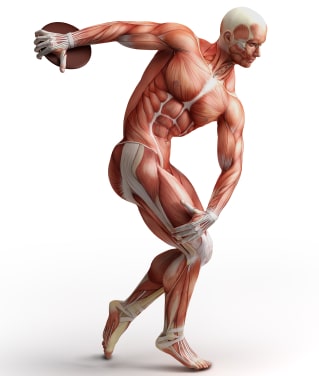 Whether you run long distances, lift weights or circuit train, you depend on muscle fibers to help you do the work. There are actually two main types of muscle fibers referred to as slow-twitch and fast-twitch muscle fibers. These fibers differ in how rapidly they can generate force, the type of energy system they use and how quickly they fatigue. Most people have roughly 50% slow-twitch fibers and 50% fast-twitch ones, but people that excel in certain sports often have a higher concentration of one fiber type over the other, which partially explains their athletic ability.
Whether you run long distances, lift weights or circuit train, you depend on muscle fibers to help you do the work. There are actually two main types of muscle fibers referred to as slow-twitch and fast-twitch muscle fibers. These fibers differ in how rapidly they can generate force, the type of energy system they use and how quickly they fatigue. Most people have roughly 50% slow-twitch fibers and 50% fast-twitch ones, but people that excel in certain sports often have a higher concentration of one fiber type over the other, which partially explains their athletic ability.
Slow-Twitch vs. Fast-Twitch Muscle Fibers: What’s the Difference?
Slow-twitch muscle fibers are called into play during endurance sports such as long distance running or cycling at a moderate pace. They have an advantage for activities that involve endurance since they use aerobic metabolism for fuel and are less resistant to fatigue. On the other hand, they have a relatively slow rate of contraction. Slow-twitch muscle fibers are fine when you’re walking at a brisk pace or jogging, but if you break into a sprint, fast-twitch muscle fibers take over.
Fast-twitch muscle fibers are superior for activities that require short periods of intense activity such as sprinting or plyometric moves that require the rapid generation of force. They use anaerobic metabolism to generate energy. The drawback is this fiber type fatigues quickly, which means they aren’t good for sports that require sustained activity.
Fast-twitch muscle fibers are also the primary ones called into play when you do heavy weightlifting. On the other hand, if you lift a weight that’s light enough that you can lift it multiple times, you’ll recruit a significant number of slow-twitch muscle fibers involved in endurance. For many activities, you use a combination of fast-twitch and slow-twitch fibers although one will usually predominate.
How Fiber Type Affects Athletic Performance
Athletic skill comes from a combination of genetics and training, but muscle fiber types play a role too. Not everyone has an equal distribution of fast-twitch and slow-twitch muscle fibers. Athletes that excel in particular sports frequently have a higher ratio of one or the other. For example, long-distance runners and athletes that participate in ultra-endurance events may have a ratio of slow-twitch fibers to fast-twitch fibers that’s greater than 9 to 1. On the other hand, power-lifters and sprinters have a higher ratio of fast-twitch to slow-twitch muscle fibers to help them generate the power they need to generate rapid force.
What if you’re a powerlifter with a high ratio of fast-twitch to slow-twitch muscle fibers, and you want to become a competitive long-distance runner? Can you turn fast-twitch muscle fibers into slow-twitch fibers through training? It was once thought that you couldn’t convert fast-twitch muscle fibers to slow-twitch ones no matter how hard you train. Now there is some evidence that fast-twitch fibers can take on the characteristics of slow-twitch ones with rigorous training over a long period of time.
Keep in mind that muscle fiber type is only one factor that determines athletic performance. Other factors such as focus, motivation, training, and nutrition are important too, but if you have a higher ratio of one fiber type over another, it could give you an advantage in certain sports.
References:
Exercise Physiology. Fifth edition. 2001. McArdle, Katch, and Katch.
PLoS Biol 2(10): e348. doi:10.1371/journal.pbio.0020348.
Related Articles By Cathe:
Muscle Fiber Types: How They Impact Exercise Performance
Can You Change the Ratio of Muscle Fibers You Have Through Training?
All About Fast-Twitch and Slow-Twitch Muscle Fibers
Muscle Fiber Composition: Are You a Fast-Twitcher or a Slow-Twitcher? Here’s How to Find Out

